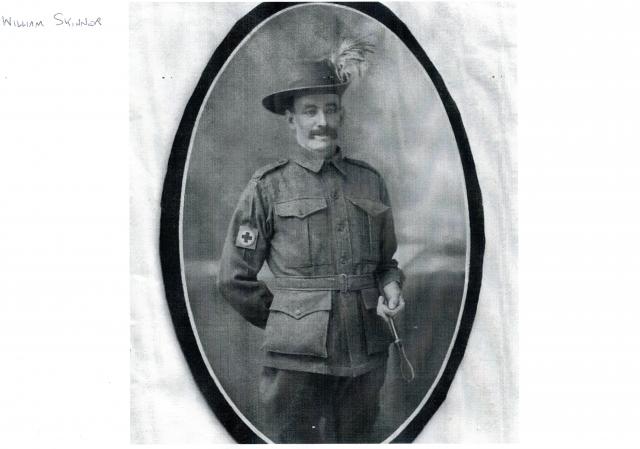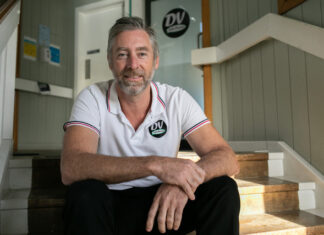It was exactly 105 years ago, on 31 October last, that amid the rifle and artillery barrage at Beersheba in World War I, as the Australian Light Horse charged upon the entrenched Turkish troops, ambulance driver Bill Skinner was sent with other ambulances to retrieve the dead and wounded at the rear of the wave of Australian Light Horsemen, and was himself wounded.
However, he became part of the legend of Beersheba on that day.
Bill survived and was taken from the battlefield back to Cairo for treatment. Here is Bill’s story of a man who had overcome his life’s early setbacks to come home from World War I, and led a very productive life.
Bill Skinner was born at Narooma, New South Wales in August 1874, to Mary Skinner from Tintenbar, who had been sent there to have her baby and later, returned to Alstonville in New South Wales four years later, to enter into an arranged marriage to a widower Frederick Beh and his children.
This was the beginning of a very unhappy early life for Bill as he suffered, through no fault of his own, the ignominy of illegitimacy. His stepfather would not accept him into the family and he was forced to eat apart from the family and sleep outside on the house verandah.
With a limited education but a fierce work ethic, Bill was forced to leave home by his stepfather at the tender age of 12. His mother Mary was a loving mother to Bill and secretly hoarded housekeeping earnings, which she passed on to him.
Bill used the money to buy a horse and dray which he used as transport for the banana growers to take their produce to Ballina.
Bill did not sit idle in the off-season for bananas, as he took on many other jobs, in particular fencing and cane cutting, with the latter paying excellent wages. He was later rated one of the best cane cutters and fencing contractors in the district.
The high wages helped Bill purchase a 130-acre property of uncleared land at Deer Vale, near Dorrigo. Here, he started the backbreaking task of clearing the land and by 1915, had completed 90 acres.
With the Australian Prime Minister, Andrew Fisher, now committing Australia to assist the Empire to “the last man and last shilling” Bill, at the age of 30, felt the need to enlist and do his duty.
When trying to enlist he was at first unsuccessful, owing to an inguinal hernia he had developed. Undeterred, Bill applied again later and was this time successful, enlisting as a non-combatant (to train as a stretcher bearer) on 8 July 1915 in Brisbane.
Bill was sent to the 2nd Light Horse Brigade Field Ambulance embarking on board HT Hymettus on 17 September 1915 and arrived at Alexandra, Egypt, around early October 1915.
Although unsure of Bill’s movements, and because he was a stretcher bearer, it is possible that he was sent to the isle of Lemnos’ 3rd Australian General Hospital to help ferry Gallipoli casualties to the main hospitals in Cairo for further treatment.
Back in Cairo Bill suffered from mumps and gastroenteritis in the early months of 1916 and spent time in the 14th Australian General Hospital at Abbassia, Egypt, and recovered at the Anzac Rest Camp at Port Said. However, his biggest setback was a re-occurrence of the inguinal Hernia he had when he was first rejected when trying to enlist. He possibly aggravated the problem when he was stretcher-bearing at Lemnos. (William was not a big man as, on enlistment, he only weighed 142 lbs and stood at 5’ 7” and sometimes, he was expected to carry two on a stretcher.)
He was transferred to the 31st Australian General Hospital when he was evacuated from the 44th Casualty Clearing Station at Kantara, to undergo radical surgery to correct the problem. Bill was also informed at this time, that his dear mother Mary had passed away back home, so it was a very sad time for him.
After a period of sick leave to recover, Bill enjoyed excursions to all the places in Palestine that he recalled in the Bible before he was posted back to the 2nd Light Horse Brigade Field Ambulance just in time to experience history when he was part of the 3rd Battle of Gaza.
It was here that Lieutenant-General Sir Harry Chauvel commanded Brigadier-General William Grant to advance under the darkness of night to attack the Turkish-held town of Beersheba and control the vital water wells there.
Bill was now to see action as a non-combatant when his ambulance, accompanied by other ambulances, joined the Desert Mounted Corps of 700 men sent to attack the 1000 Turkish troops holding the Fort. The ambulances were basically a horse-drawn cart with a red cross emblem on the canopy, and the driver had to mount the horse to drive the cart.
At 5pm on 31 October 1917, the Mounted Corps took the strategic water holes with a decisive victory that has become a legend in Australian Anzac history.
Despite Australian casualties of 31 dead, 37 wounded, and 70 horses killed as well as 171 British cavalry dead, the charge was a decisive victory. They took over 700 prisoners with around 300 Turkish dead and wounded, and more importantly, the water wells of the Fort.
Bill was with the Ambulance Brigade following the charge when his horse was shot causing the cart to overturn and the horse falling on his knee. He was later picked up from the battlefield by the ambulance brigade and taken to hospital for surgery on a serious knee injury.
The injury brought William’s war to an end so after recovery, he was posted to the 14 Australian General Hospital for nursing and Wardsman’s duty on board the HT Ulysses, leaving Egypt on 22nd February 1918.
A short time after arriving in Australia, he was finally discharged as medically unfit on 4th June 1918.
With the war over, Bill returned to his Dorrigo property to a farm and house he had built for the future. As was Bill’s fastidious nature, he had spent hours building a house that would last for years, and soon after, met a young lass from Alstonville named Olive Napper, who was a bookkeeper at a local dress shop.
Bill and Olive were married soon after and lived happily on the property all their lives and raised two children named Harold and Violet. Bill then became a successful dairy farmer producing and supplying cream to the Norco Dairy Company at Dorrigo. His preference in cows was for Jerseys who he deemed produced a better quality of milk and soon after, he started a Jersey Stud.
Bill Skinner passed away in 1959 mourned greatly by Olive and his family. But Bill left a great legacy for a man who had started life as an unwanted child in a household dominated by a step-father, who turned him out at an early age.
However, Bill Skinner was a man determined to not let this early experience deter him from a better life, with a work ethic that enabled him to reach the top of his trade as a respected tradesman in fencing and cane cutting.
In 1915, although he was a conscientious objector, Bill still wanted to do his national duty and so enlisted as a non-combatant, where his military service as an Anzac gave him the opportunity to engage in what historians say was the “last cavalry charge in history” with the Australian Light Horse offensive at Beersheba in 1917.
Bill’s family and especially his grandson John Skinner, president of the Warwick RSL Sub-Branch, can be justly proud of this legacy. It is certain that despite the many years that have passed, on 31 October and on each Anzac Day, he will never be forgotten.







